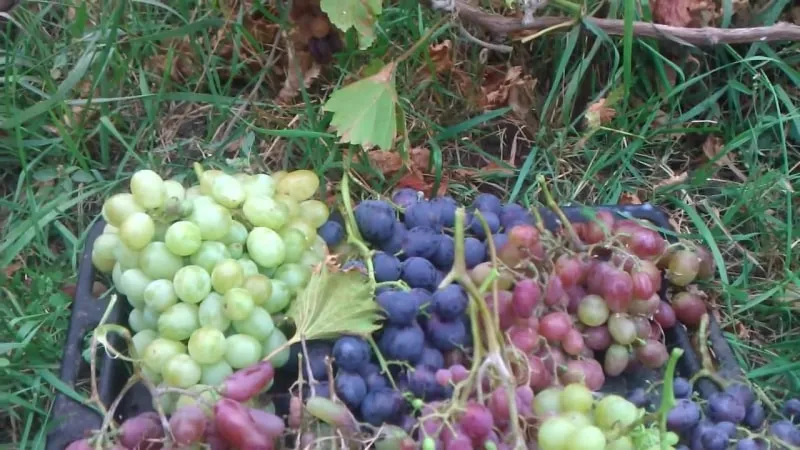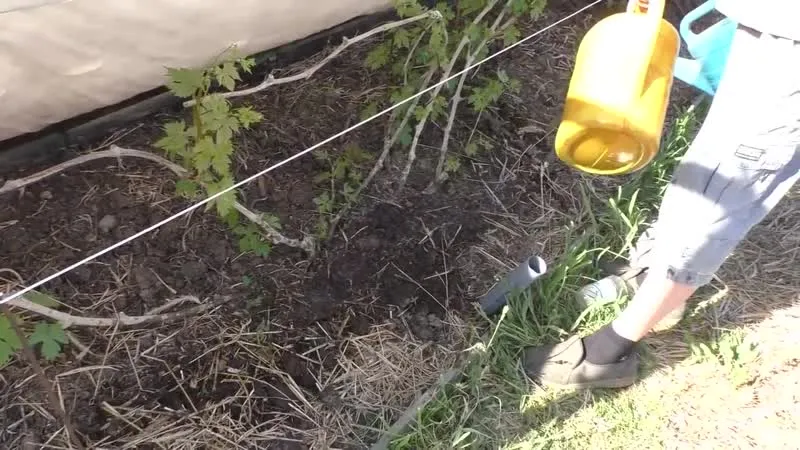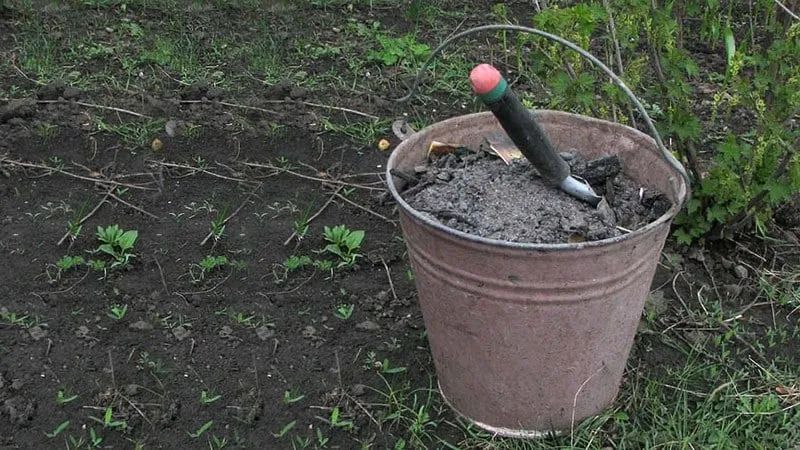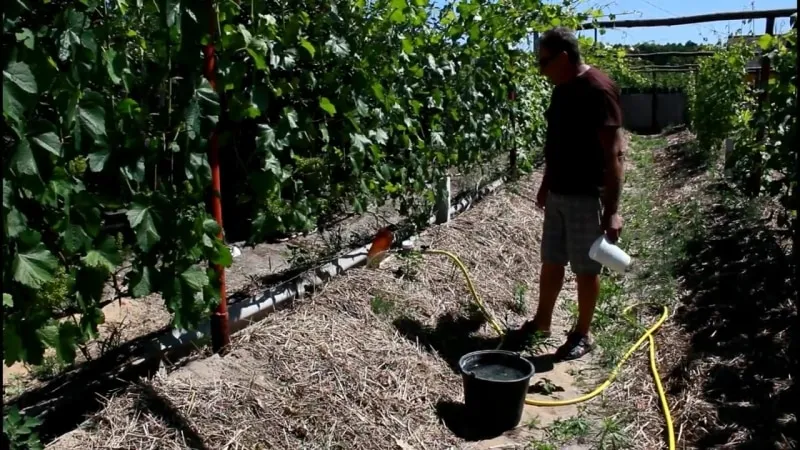The foundation for next year's grape harvest is laid in autumn. It's essential to nourish the vines thoroughly to strengthen them, enhance their cold resistance, and ensure a healthy dormant period. Providing plants with proper nutrition before winter ensures dense clusters of large, sweet berries.
The schedule for autumn grape fertilisation depends on the harvest time and the onset of frost.
Table of contents
What Grapes Need in Autumn

After harvesting, preparations for the next year's crop begin. Grapevines should enter winter without green, unripe shoots.
Plants require:
- potassium;
- calcium;
- phosphorus;
- boron.
Potassium fertilisers are quickly absorbed by the vines, strengthening the branches. Green shoots mature, develop brown bark, and withstand winter cold more effectively. With sufficient potassium, clusters form large, and berries resist cracking after heavy rains or drought. A deficiency leads to leaf decay.
Calcium plays a role in metabolic processes, root development, and pollen germination.
Phosphorus accumulates slowly in grapevines, so the effects of autumn fertilisation become evident in early spring. It promotes abundant fruit set and large clusters with big berries.
Without boron, pollen production is minimal, flowers remain unfertilised, and fruit set is poor. Clusters become loose with few berries.
Additional benefits of boron:
- improves metabolism;
- enhances leaf vibrancy by increasing chlorophyll content;
- accelerates nitrogen synthesis.
Excessive boron harms plants, so it should be applied as directed on the packaging, no more than once every three years.
Timing for Autumn Fertilisation
If young grapevines are planted correctly, their initial nutrient reserves last 3–5 years, depending on soil type. Dense, rocky soils retain nutrients longer, while sandy soils lose them faster.
The first comprehensive autumn fertilisation is applied in the 4th year after planting and repeated every 3 years. Potassium and phosphorus are supplied, along with mineral and organic fertilisers, immediately after harvest.
Monthly Fertilisation Guide

A bountiful harvest depletes the vines' energy. Five fertilisation rounds are recommended per season:
- In May, once warm weather sets in. Apply 10 litres of water mixed with 10 g ammonium nitrate, 20 g superphosphate, and 5 g potassium salt per plant. Alternatively, use poultry manure.
- Late May – early June. Two weeks before flowering, repeat the same mix. Dry granules can be spread around the planting hole: 40 g nitrogen and potassium fertilisers, 50 g superphosphate per vine.
- In July, between flowering and ripening, when berries are pea-sized. Apply superphosphate and potassium fertilisers. Cow manure works well as an organic alternative.
- In August, during berry ripening. Apply 50 g potassium and 100 g phosphorus fertilisers per vine.
- In September. Use a potassium-phosphorus mix with boron.
Mulching the planting holes with straw is recommended.
Note: These timings are for temperate climates. Adjust based on local conditions and grape variety.
Root Fertilisation
This method is crucial for vine development and fruiting. Apply fertilisers to the soil 50–80 cm from the trunk, either as buried granules or liquid solutions.
Foliar Feeding
Heavy fruit loads strain vines, making it harder for roots to absorb nutrients. Supplemental foliar sprays help.
Begin foliar feeding in early spring at +10°C. Spray leaves and canes 3–5 times before fruit set (7–10-day intervals), then again post-harvest.
Tip: Foliar sprays can also be used in summer, except during flowering.
Spraying is best done in the evening under these conditions:
- dry leaves (no dew or rain);
- air temperature below +23°C;
- calm, overcast weather.
Hot daytime temperatures risk leaf burns and fruit drop.
Post-harvest, spray vines with an ash solution (150 ml per 10 L water, steeped for 2 weeks).
Dissolve mineral fertilisers in warm water before diluting as directed. Add insecticides or fungicides if needed. Well-fed vines overwinter better and thrive in spring.

Types of Fertilisers
Fertilisers fall into organic and mineral categories.
Organic options include compost, wood ash, manure, and poultry droppings.
Mineral fertilisers are industrially produced, containing pure elements like:
- urea;
- potassium;
- phosphorus;
- ammonium nitrate.
These come as single or multi-nutrient (complex) formulas.
For optimal vine growth and high yields, use both types.

Autumn Fertilisers for Grapes
After harvest, shoot growth stops. Vines need potassium and phosphorus to recover and withstand winter.
Commercial Fertilisers
Common single-nutrient fertilisers for grapes:
- potassium salt;
- granulated superphosphate;
- potassium chloride;
- potassium magnesium sulfate;
- urea;
- potassium sulfate.
Apply 50–100 g potassium and phosphorus per vine, others in smaller doses.
Multi-nutrient formulas provide balanced nutrition. Suitable options:
- NPK (Nitrogen-Phosphorus-Potassium);
- Compo;
- Biobizz;
- Osmocote;
- Plantafol;
- Florovit.
Follow package instructions for dosage.

Homemade Solutions
Organic alternatives include:
- wood ash;
- compost;
- peat;
- well-rotted manure;
- eggshells;
- poultry droppings.
Wood ash can be sprinkled or steeped in water. Peat is best mixed with manure.
Tip: Traditionally, manure was stockpiled in pits over winter, then spread between rows in spring. Rainwater carried nutrients deep into the soil.
Poultry manure releases nitrogen as it decomposes. Steep in water for 2 weeks before use.
Crushed eggshells provide calcium—dry, grind, and apply in autumn.
How to Fertilise Grapes in Autumn
Applying fertilisers near trunks feeds only surface roots, leading to excessive foliage and poor fruiting.
Key point: Deep roots matter more than shallow ones—they recover slowly if damaged.
To reach deep roots, place fertilisers 50–80 cm from the trunk (depending on vine age). Use trenches or holes to prevent drying and ensure nutrient penetration.

Step-by-Step Guide
Autumn care combines soil aeration, fertilisation, and weed removal:
- Loosen soil in a 50–60 cm radius around vines.
- Dig 20 cm-deep trenches at the perimeter.
- Water deeply through these trenches.
- Add slow-release fertilisers (e.g., potassium magnesium sulfate, rock phosphate) and cover with soil.
Spread well-rotted manure or ash 30 cm from trunks. Avoid fresh manure—use aged compost instead.
Dilute poultry manure (1:4 with water after fermentation) and apply 3 buckets per vine at the trench edge.
After watering, mulch with leaves or straw to retain moisture and insulate roots.
Regional Variations in Autumn Care
Vine dormancy periods vary by climate.
Apply fertilisers 3–4 weeks before frost:
- Southern Europe (e.g., Spain, Italy) – mid-October;
- Central Europe (e.g., Germany, France) – late September;
- Northern Europe (e.g., Scandinavia) – early September;
- Alpine regions – late August.
Table grape varieties tolerate temperatures down to -20°C. In southern regions, pruning and light mulching suffice.
In cooler areas, vines need winter protection—remove from trellises and cover with straw or conifer branches.
Conclusion
Grape cultivation demands year-round attention. Autumn fertilisation strengthens vines, boosts next season's yield, and prepares plants for winter. It enhances disease resistance and ensures healthy spring growth.







